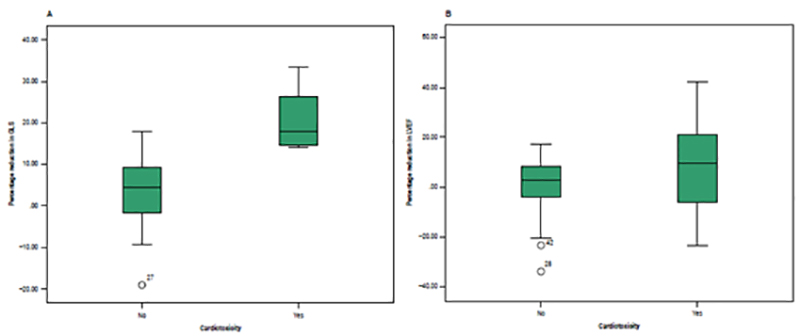Volume 110, Nº 2, February 2018
DOI: http://www.dx.doi.org/10.5935/abc.20180021
ORIGINAL ARTICLE
Global Longitudinal Strain Accuracy for Cardiotoxicity Prediction in a Cohort of Breast Cancer Patients During Anthracycline and/or Trastuzumab Treatment
Eliza de Almeida Gripp
Gabriela Escudini de Oliveira
Luiz Augusto Feijó
Marcelo Iorio Garcia
Sergio Salles Xavier
Andréa Silvestre de Sousa

Figure 2 – Boxplot illustrating the difference between the groups with and without cardiotoxicity. A, percentage reduction in left ventricular global longitudinal strain (GLS) variation; and B, percentage reduction in left ventricular ejection fraction (LVEF) variation.
Abstract
Background: The high cardiotoxicity morbidity and mortality rates associated with the antineoplastic therapy for breast cancer could be reduced with the early use of cardioprotective drugs. However, the low sensitivity of left ventricular ejection fraction limits its use in that preventive strategy. New parameters, such as global longitudinal strain, are being used in the early detection of contractile function changes.
Objectives: To assess the incidence of cardiotoxicity in patients treated for breast cancer, the independent factors associated with that event, and the ability of strain to identify it early.
Methods: Prospective observational study of consecutive outpatients diagnosed with breast cancer, with no previous antineoplastic treatment and no ventricular dysfunction, who underwent anthracycline and/or trastuzumab therapy. The patients were quarterly evaluated on a 6- to 12-month follow-up by an observer blind to therapy. Cox regression was used to evaluate the association of cardiotoxicity with clinical, therapeutic and echocardiographic variables. A ROC curve was built to identify the strain cutoff point on the third month that could predict the ejection fraction reduction on the sixth month. For all tests, the statistical significance level adopted was p ≤ 0.05.
Results: Of 49 women (mean age, 49.7 ± 12.2 years), cardiotoxicity was identified in 5 (10%) on the third (n = 2) and sixth (n = 3) months of follow-up. Strain was independently associated with the event (p = 0.004; HR = 2.77; 95%CI: 1.39-5.54), with a cutoff point for absolute value of -16.6 (AUC = 0.95; 95%CI: 0.87-1.0) or a cutoff point for percentage reduction of 14% (AUC = 0.97; 95%CI: 0.9-1.0).
Conclusion: The 14% reduction in strain (absolute value of -16.6) allowed the early identification of patients who could develop anthracycline and/or trastuzumab-induced cardiotoxicity. (Arq Bras Cardiol. 2018; 110(2):140-150)
Keywords: Breast Neoplasms/drug therapy; Cardiotoxicity; Stroke Volume; Trastuzumab; Indicators of Morbidity and Mortality.















